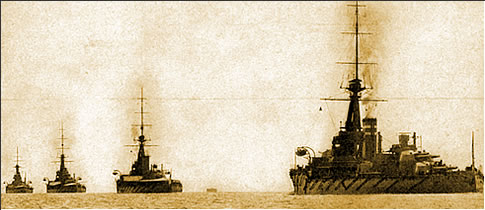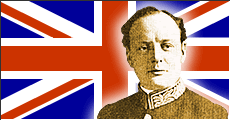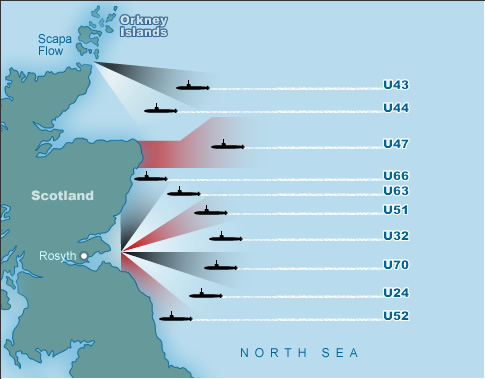The Battle of Jutland
Background to the Battle

The Intentions of the Two Sides
During World War I, the British had a much bigger navy than the Germans. Britain needed more fighting ships than Germany because, as an island, she was dependent on imports of food and raw materials from other parts of the world - all of which needed to be protected on the high seas in time of war.
Britain also needed a large navy to protect her colonies and to protect supplies being sent to the army fighting in France. Above all, a strong navy was necessary to protect Britain itself from invasion.
The Royal Navy had a long tradition of fighting and winning decisive battles. In World War I, the British Grand Fleet hoped to meet and destroy the German High Seas Fleet in a pitched battle, but both sides were reluctant to commit themselves.
The Germans knew that they could not take on the much larger British Grand Fleet, whilst the British knew they had little to gain from a victory and everything to lose by a defeat.
Destruction of the German High Seas Fleet would not harm Germany’s war effort in the slightest, whilst defeat – unlikely, but possible - would cause Britain to lose the war. Because of this, Winston Churchill who was the First Sea Lord at that time, famously said of Admiral Jellicoe that he was the only commander on either side who was capable of losing the war in a single afternoon.
 "Admiral Jellicoe is the only commander on either side capable of losing the war in a single afternoon."
"Admiral Jellicoe is the only commander on either side capable of losing the war in a single afternoon."
Winston Churchill
First Sea Lord
Knowing their battle fleet was weak in its number of battleships, the Germans planned to avoid an all-out battle until they could first sink enough British warships to make the numbers more even.
In 1916, the German plan was to lure parts of the British Grand Fleet out into the North Sea by swift surface raids on East coast towns such as Scarborough and Sunderland. Meanwhile, German submarines were stationed several miles outside the main British naval bases of Rosyth and Scapa Flow for the purpose of sinking British battleships with torpedoes as they left port to deal with the surface raids.

However this plan proved ineffective as the German U-boats failed to sink a single British warship. Towards the end of May 1916, Admiral Scheer, Commander of the German High Seas Fleet, decided on a further - more risky - decoy operation to lure British battleships out of port.
He decided to lead the whole of the German High Seas Fleet out into the North Sea, sending his battlecruisers under Admiral Hipper ahead as a decoy to attack merchant shipping in the sea passage between Denmark and Norway, known as the Skagerrak.
Scheer’s intention, as before, was not to fight a pitched battle but to lure Admiral Beatty’s battlecruisers out of Rosyth to attack Hipper and then fall on Beatty with the whole might of the German High Seas Fleet.
Unknown to Scheer however, the British were able to decode German radio messages. Scheer’s messages to Hipper were intercepted and passed to Admiral Jellicoe, who immediately ordered the British Grand Fleet to sea under cover of darkness to avoid the waiting German submarines.
By midnight on 30th May 1916, Jellicoe and Beatty were at sea - five hours before Scheer and the German High Seas Fleet had left their port at Wilhelmshaven!
